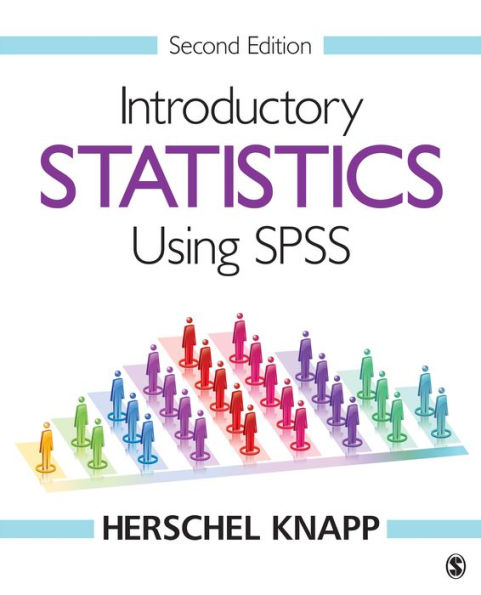5
1
9781506341002


Introductory Statistics Using SPSS / Edition 2 available in Paperback, eBook

Introductory Statistics Using SPSS / Edition 2
by Herschel Knapp
Herschel Knapp
- ISBN-10:
- 1506341004
- ISBN-13:
- 9781506341002
- Pub. Date:
- 11/02/2016
- Publisher:
- SAGE Publications
- ISBN-10:
- 1506341004
- ISBN-13:
- 9781506341002
- Pub. Date:
- 11/02/2016
- Publisher:
- SAGE Publications

Introductory Statistics Using SPSS / Edition 2
by Herschel Knapp
Herschel Knapp
$129.0
Current price is , Original price is $129.0. You
Buy New
$129.00Buy Used
$79.90
$129.00
-
SHIP THIS ITEM— This item is available online through Marketplace sellers.
-
PICK UP IN STORECheck Availability at Nearby Stores
Available within 2 business hours
This item is available online through Marketplace sellers.
-
SHIP THIS ITEM
Temporarily Out of Stock Online
Please check back later for updated availability.
This item is available online through Marketplace sellers.
129.0
Out Of Stock
Overview
The updated Second Edition of Herschel Knapp’s friendly and practical introduction to statistics shows students how to properly select, process, and interpret statistics without heavy emphasis on theory, formula derivations, or abstract mathematical concepts. Each chapter is structured to answer questions that students most want answered: What statistical test should I use for this situation? How do I set up the data? How do I run the test? How do I interpret and document the results? Online tutorial videos, examples, screenshots, and intuitive illustrations help students "get the story" from their data as they learn by doing, completing practice exercises at the end of each chapter using prepared downloadable data sets.

Product Details
| ISBN-13: | 9781506341002 |
|---|---|
| Publisher: | SAGE Publications |
| Publication date: | 11/02/2016 |
| Edition description: | Second Edition |
| Pages: | 312 |
| Product dimensions: | 7.30(w) x 9.10(h) x 0.80(d) |
About the Author
Herschel Knapp, Ph D, MSSW, has more than 25 years of experience as a health care professional in a variety of domains. In addition to his clinical work as a psychotherapist, primarily in hospital settings, he has provided project management for innovative implementations designed to improve the quality of patient care via multisite, health science implementations. He teaches master’s-level courses at the University of Southern California; he has also taught at the University of California, Los Angeles and California State University, Los Angeles. Dr. Knapp has served as the lead statistician on a longitudinal cancer research project and managed the program evaluation metrics for a multisite, nonprofit children’s center. His clinical work includes emergency/trauma therapy in hospital settings. Dr. Knapp has developed and implemented innovative telehealth systems, utilizing videoconferencing technology to facilitate optimal health care service delivery to remote patients and to coordinate specialty consultations among health care providers, including interventions to diagnose and treat people with HIV and hepatitis, with special outreach to the homeless. He is currently leading a nurse research mentorship program and providing research and analytic services to promote excellence within a health care system. The author of numerous articles in peer-reviewed health science journals, he is also the author of other textbooks, including Introductory Statistics Using SPSS (2nd ed., 2017), Practical Statistics for Nursing Using SPSS (2017), Therapeutic Communication: Developing Professional Skills (2nd ed., 2014), and Introduction to Social Work Practice: A Practical Workbook (2010).
Table of Contents
PrefaceAcknowledgmentsAbout the AuthorPART I: STATISTICAL PRINCIPLES1. Research PrinciplesLearning ObjectivesOverview—Research PrinciplesRationale for StatisticsResearch QuestionsTreatment and Control GroupsRationale for Random AssignmentHypothesis FormulationReading Statistical OutcomesAccept or Reject HypothesesVariable Types and Levels of MeasureContinuousIntervalRatioCategoricalNominalOrdinalGood Common SenseKey ConceptsPractice Exercises2. SamplingLearning ObjectivesOverview—SamplingRationale for SamplingTimeCostFeasibilityExtrapolationSampling TerminologyPopulationSample FrameSampleRepresentative SampleProbability SamplingSimple Random SamplingStratified SamplingProportionate and Disproportionate SamplingSystematic SamplingArea SamplingNonprobability SamplingConvenience SamplingPurposive SamplingQuota SamplingSnowball SamplingSampling BiasOptimal Sample SizeGood Common SenseKey ConceptsPractice Exercises3. Working in SPSSLearning ObjectivesVideoOverview—SPSSTwo Views: Variable View and Data ViewVariable ViewNameTypeWidthDecimalsLabelValuesMissingColumnsAlignMeasureRoleData ViewValue Labels IconCodebookSaving Data FilesGood Common SenseKey ConceptsPractice ExercisesPART II: STATISTICAL PROCESSES4. Descriptive StatisticsLearning ObjectivesVideosOverview—Descriptive StatisticsDescriptive StatisticsNumber (n)Mean (µ)MedianModeStandard Deviation (SD)VarianceMinimumMaximumRangeSPSS—Loading an SPSS Data FileRun SPSSData SetTest RunSPSS—Descriptive Statistics: Continuous Variables (age)Statistics TablesHistogram With Normal CurveSkewed DistributionSPSS—Descriptive Statistics: Categorical Variables (gender)Statistics TablesBar ChartSPSS—Descriptive Statistics: Continuous Variable (age) Select by Categorical Variable (gender)—Female or Male OnlySPSS—(Re)Selecting All VariablesGood Common SenseKey ConceptsPractice Exercises5. t Test and Mann-Whitney U TestLearning ObjectivesVideosOverview—t TestExampleResearch QuestionGroupsProcedureHypothesesData SetPretest ChecklistPretest Checklist Criterion 1—NormalityPretest Checklist Criterion 2—n QuotaPretest Checklist Criterion 3—Homogeneity of VarianceTest RunResultsPretest Checklist Criterion 2—n QuotaPretest Checklist Criterion 3—Homogeneity of Variancep ValueHypothesis Resolutiona LevelDocumenting ResultsType I and Type II ErrorsType I ErrorType II ErrorOverview—Mann-Whitney U TestTest RunResultsGood Common SenseKey ConceptsPractice Exercises6. ANOVA and Kruskal-Wallis TestLearning ObjectivesVideosLayered LearningOverview—ANOVAExampleResearch QuestionGroupsProcedureHypothesesData SetPretest ChecklistPretest Checklist Criterion 1—NormalityPretest Checklist Criterion 2—n QuotaPretest Checklist Criterion 3—Homogeneity of VarianceTest RunResultsPretest Checklist Criterion 2—n QuotaPretest Checklist Criterion 3—Homogeneity of VarianceComparison 1—Text : Text With IllustrationsComparison 2—Text : VideoComparison 3—Text With Illustrations : VideoHypothesis ResolutionDocumenting ResultsOverview—Kruskal-Wallis TestTest RunResultsGood Common SenseKey ConceptsPractice Exercises7. Paired t Test and Wilcoxon TestLearning ObjectivesVideosOverview—Paired t TestPretest/Posttest DesignStep 1: PretestStep 2: TreatmentStep 3: PosttestExampleResearch QuestionGroupsProcedureStep 1: PretestStep 2: TreatmentStep 3: PosttestHypothesesData SetPretest ChecklistPretest Checklist Criterion 1—Normality of DifferenceTest RunResultsHypothesis ResolutionDocumenting ResultsΔ% FormulaOverview—Wilcoxon TestTest RunResultsGood Common SenseKey ConceptsPractice Exercises8. Correlation and Regression—Pearson and SpearmanLearning ObjectivesVideosOverview—Pearson CorrelationExample 1—Pearson RegressionResearch QuestionGroupsProcedureHypothesesData SetPretest ChecklistPretest Checklist Criterion 1—NormalityTest RunCorrelationRegression (Scatterplot With Regression Line)ResultsScatterplot PointsScatterplot Regression LinePretest Checklist Criterion 2—LinearityPretest Checklist Criterion 3—HomoscedasticityCorrelationHypothesis ResolutionDocumenting ResultsNegative CorrelationNo CorrelationOverview—Spearman CorrelationExample 2—Spearman CorrelationResearch QuestionGroupsProcedureHypothesesData SetPretest ChecklistTest RunResultsHypothesis ResolutionDocumenting ResultsAlternative Use for Spearman CorrelationCorrelation Versus CausationOverview—Other Types of Statistical Regression: Multiple Regression and Logistic RegressionMultiple Regression (R2)Logistic RegressionGood Common SenseKey ConceptsPractice Exercises9. Chi-SquareLearning ObjectivesVideoOverview—Chi-SquareExampleResearch QuestionGroupsProcedureHypothesesData SetPretest ChecklistPretest Checklist Criterion 1—n = 5 per CellTest RunResultsPretest Checklist Criterion 1—n = 5 per CellHypothesis ResolutionDocumenting ResultsGood Common SenseKey ConceptsPractice ExercisesPART III: DATA HANDLING10. Supplemental SPSS OperationsLearning ObjectivesData SetsOverview—Supplemental SPSS OperationsGenerating Random NumbersSort CasesData SetSelect CasesData SetRecodingData SetImporting DataImporting Excel DataData SetImporting ASCII Data (Generic Text File)Data SetSPSS SyntaxData SetData SetsGood Common SenseKey ConceptsPractice ExercisesGlossaryIndexFrom the B&N Reads Blog
Page 1 of
